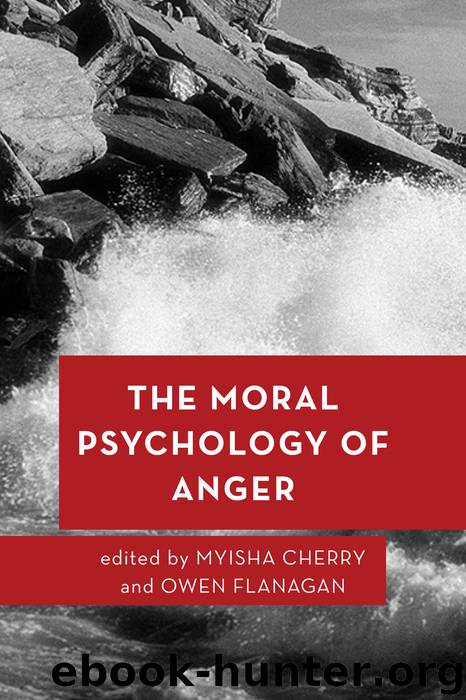The Moral Psychology of Anger by Unknown

Author:Unknown
Language: eng
Format: epub
ISBN: 9781786600776
Publisher: National Book Network International
RESPONDING TO THE CHARGE OF INCOHERENCE
Nussbaum’s initial complaint is explicitly about blaming anger, claiming that it is incoherent, as it conceptually involves a wish for payback or, more precisely, involves “a retributive and hopeful outward movement that seeks the pain of the offender because of and as a way of compensating for one’s own damage” (Nussbaum 2015: 47). This is obviously magical thinking, however, as getting the offender back won’t assuage or compensate for the lost value. Consequently, we should give up this form of anger as a leftover from a more intellectually unsophisticated time.
One might well think, however, that fitting anger doesn’t aim at rectifying damage. Rather, it could aim, as Aristotle suggested, at restoring one’s (moral) status, which the offender downgraded. On this view, when the injured party angrily retaliates against the offender, the moral balance has been restored, or at least the positions have been reversed. And that doesn’t seem magical or incoherent at all.
Nussbaum considers this possibility, but she rejects it as well, this time on moral grounds, as it expresses an objectionable sort of narcissism, a fussy focus on one’s own vulnerability and relative status. And if that is the aim when we are angry at those who hurt our friends, then its focus on the downgrading to ourselves is certainly misplaced.
There remains, for Nussbaum, only one possible rational aim of anger, and that is an utterly forward-looking utilitarian aim: to assess what can be done in light of the offense that would be most helpful for all affected parties. This could include punishing the offender but with an ameliorative, not retaliatory, end in mind (Nussbaum 2015: 50).
I will take up Nussbaum’s (and others’) moral objections to anger in the next section, but for now, there is a response worth making to her view about the three possible aims of blaming anger. None of these is quite right. To see what its actual aim is, we need to think about its successful resolution.
I have spoken thus far only about the action tendency of blaming anger, which aims to communicate itself. But what does it aim to communicate? To see what it is, consider cases in which my fitting blaming anger at you becomes unfitting. Sometimes this occurs when you have done everything we could reasonably ask of you in response to injuring me. In such a case, my forgiveness is appropriate; I no longer have reasons of fit to feel blaming anger at you. What precisely do you have to do to successfully render my blaming anger no longer fitting in this way?
In the empirical psychological literature, there are several items that people cite that successfully effect forgiveness, including the offender’s making amends or admitting fault (see Schmitt et al. 2004; Zechmeister et al. 2004; Dill and Darwall 2014: 51). But by far the best predictor of forgiveness is sincerely expressed remorse (Davis and Gold 2011: 392). This is a ruminative emotion, its action tendency being to think over and over again, usually in a pained way, about the loss of or damage to a value that one caused (Thomas 1999: 130).
Download
This site does not store any files on its server. We only index and link to content provided by other sites. Please contact the content providers to delete copyright contents if any and email us, we'll remove relevant links or contents immediately.
Still Foolin’ ’Em by Billy Crystal(36037)
We're Going to Need More Wine by Gabrielle Union(18626)
Plagued by Fire by Paul Hendrickson(17106)
Molly's Game by Molly Bloom(13885)
Pimp by Iceberg Slim(13774)
Becoming by Michelle Obama(9753)
When Breath Becomes Air by Paul Kalanithi(8037)
Educated by Tara Westover(7687)
The Girl Without a Voice by Casey Watson(7599)
Note to Self by Connor Franta(7451)
The Incest Diary by Anonymous(7419)
How to Be a Bawse: A Guide to Conquering Life by Lilly Singh(7154)
The Space Between by Michelle L. Teichman(6569)
What Does This Button Do? by Bruce Dickinson(5931)
Imperfect by Sanjay Manjrekar(5678)
Permanent Record by Edward Snowden(5536)
A Year in the Merde by Stephen Clarke(5074)
Recovery by Russell Brand(4916)
Promise Me, Dad by Joe Biden(4907)
